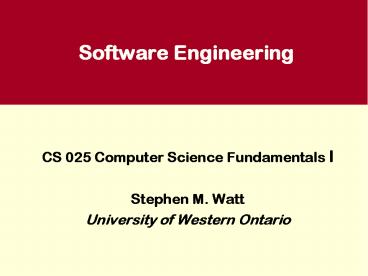Software Engineering PowerPoint PPT Presentation
Title: Software Engineering
1
Software Engineering
- CS 025 Computer Science Fundamentals I
- Stephen M. Watt
- University of Western Ontario
2
Software Engineering
- Writing small programs is easy.
- Writing big programs is hard.
- This sounds trivial, but therein lies a deeper
truth.
3
Software Engineering
- Why are bigger programs harder to work withthan
smaller programs? - There are at least two reasons
- The problems they are trying to solve are
inherentlymore difficult and more complex. - They have more interacting parts.
4
Interactions Among Parts
- 1 part gt no interactions
- 2 parts gt 1 pair-wise interaction
- 3 parts gt 3 2-way interactions, 1 3-way
interaction - 4 parts gt 6 2-way interactions, 4 3-way
interactions 1 4-way
interaction. - 100 parts gt 4950 2-way interactions
161,700 3 -way
interactions 3,921,225
4-way interactions ... - 1000 parts gt 499,500 2-way
interactions 166,167,000
3-way interactions
41,416,124,750 4-way interactions ... - n parts gt n (n-1)/2 2-way interactions
2n (n1) interactions all
together.
5
Interaction Among Parts
- This growth in possible number of interactions
among parts leads to - New emergent phenomena at each level ofprogram
size.Different concerns arise in programs with
100 n lines that do not exist in programs of
with n lines. This is true for all n. - One of the most important considerations
insoftware design becomes limiting the
interactionamong parts.
6
Smart Choice of Parts
- One of the most important aspects of software
designis in deciding what the parts of a program
will be. - This is problem decomposition.
- A good choice of parts will provide
- re-usable components, with
- well-defined interfaces that
- allow parts to be composed flexibly and
- stylize the interaction among parts
- Think Lego bricks, not Swiss army knives.
7
What are the Parts?
- Depends on the programming environmentand the
granularity. - Lines of code.
- Methods or functions.
- Classes or modules.
- Packages.
- Application suites.
- Computer systems.
- Networks.
- Planetary infrastructures.
8
Software Engineering
- Software Engineering is the body of knowledge
andpractice of managing the life-cycle of
software. - It focuses on how teams of people candesign,
build, test, deploy and maintain software
modules.
9
Top-Down vs Bottom-Up vs Middle-Out
- There are various ways to design software, each
with its own adherents. - Top-down software design is based on successive
refinement of ideas. - Bottom-up software design is based on crafting
basic modules and successively abstracting
interfaces. - Middle-out software design is based onstarting
in the middle and doing both. - (Until you have a lot more experience top-down
is the best.)
10
What Does Wikipedia Say?
- Top-down and bottom-up are strategies of
information processing and knowledge ordering,
mostly involving software, and by extension other
humanistic and scientific system theories (see
systemics). - In a top-down approach an overview of the system
is first formulated, specifying but not
detailing any first-level subsystems. Each
subsystem is then refined in yet greater detail,
sometimes in many additional subsystem levels,
until the entire specification is reduced to base
elements.A top-down model is often specified
with the assistance of "black boxes" that make
it easier to manipulate. However, black boxes may
fail to elucidate elementary mechanisms or be
detailed enough to realistically validate the
model. - In a bottom-up approach the individual base
elements of the system are first specified in
great detail. These elements are then linked
together to form larger subsystems, which then
in turn are linked, sometimes in many levels,
until a complete top-level system is formed. This
strategy often resembles a "seed" model, whereby
the beginnings are small, but eventually grow in
complexity and completeness. However, "organic
strategies", may result in a tangle of elements
and subsystems, developed in isolation, and
subject to local optimization as opposed to
meeting a global purpose.
11
Example of Top-Down Design
- Write a program to verify that a 9 x 9 grid is a
Sudoku solution. - Each row and column and 3x3 square (indicated by
heavy lines)must have each of the digits 1-9. - Because each row, column and 3x3square have
exactly 9 places, thisimplies that each digit
appears exactlyonce in each of them.

